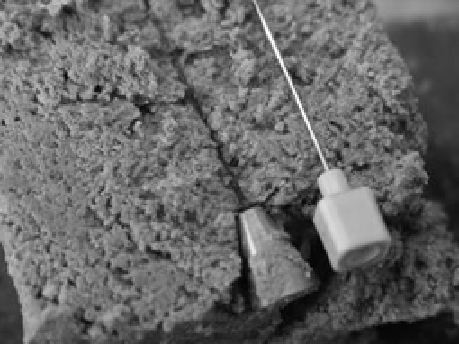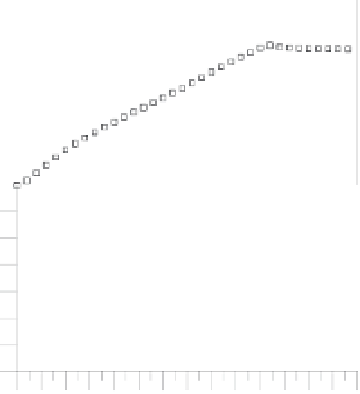Environmental Engineering Reference
In-Depth Information
400
NB-4 (23.6-23.8m) (compacted state)
soaking at constant vert. stress
initial water content: 32%
NB-4 (23.6-23.8m) (compacted state)
0.0
300
200
0.5
100
1.0
0
0
100
200
300
400
Vertical effective stress,
σ
'
v
(kPa)
1.5
Figure 15. shear strength envelope for ultimate condi-
tions. compacted sample nB-4. shear strength parameters.
0
100
200
300
400
Vertical stress (kPa)
Figure 13. evolution of vertical strain (collapse) dur-
ing soaking at different vertical stresses. compacted
sample nB-4.
500
NB-4 (23.6-23.8m) (compacted state)
σ
'
v
= 52kPa
400
σ
'
v
= 104kPa
σ
'
v
= 208kPa
300
σ
'
v
= 364kPa
200
100
0
-0.4
-0.2
0
0.2
0.4
0.6
0.8
Figure 16. compacted tuff sample. saturated sample
after pinhole test. The 1 mm hole did not erode.
practice is dependent on the amount of “damage”
or remoulding induced by excavation and compac-
tion procedure.
02468 0 21
Horizontal displacement (mm)
4
Figure 14. evolution of shear stresses and vertical
displacements during direct shear test on compacted
sample nB-4.
2.7
Hydraulic-related behaviour
a water permeability test was also run on com-
pacted sample nB-4 using controlled-gradient
conditions in an oedometer cell under loaded
conditions (50 mm diameter and 20 mm high
specimen). The vertical total stress applied was 75
kPa. Water pressure of 30 kPa was applied at the
bottom of the sample. Pressure at the top of the
sample was maintained under atmospheric condi-
tions. a saturated permeability of
k
= 3.5 × 10
-10
m/s under steady state conditions was measured.
compression stress). Figure 15 shows the shear
strength envelopes for ultimate conditions, and the
shear strength parameters.
compacted tuff exhibits a high drained fric-
tion angle (43°) and a ductile behaviour. however,
when remoulded and tested for residual condi-
tions the friction reduced to 29°. The question of
the appropriate strength parameters to be used in
























































